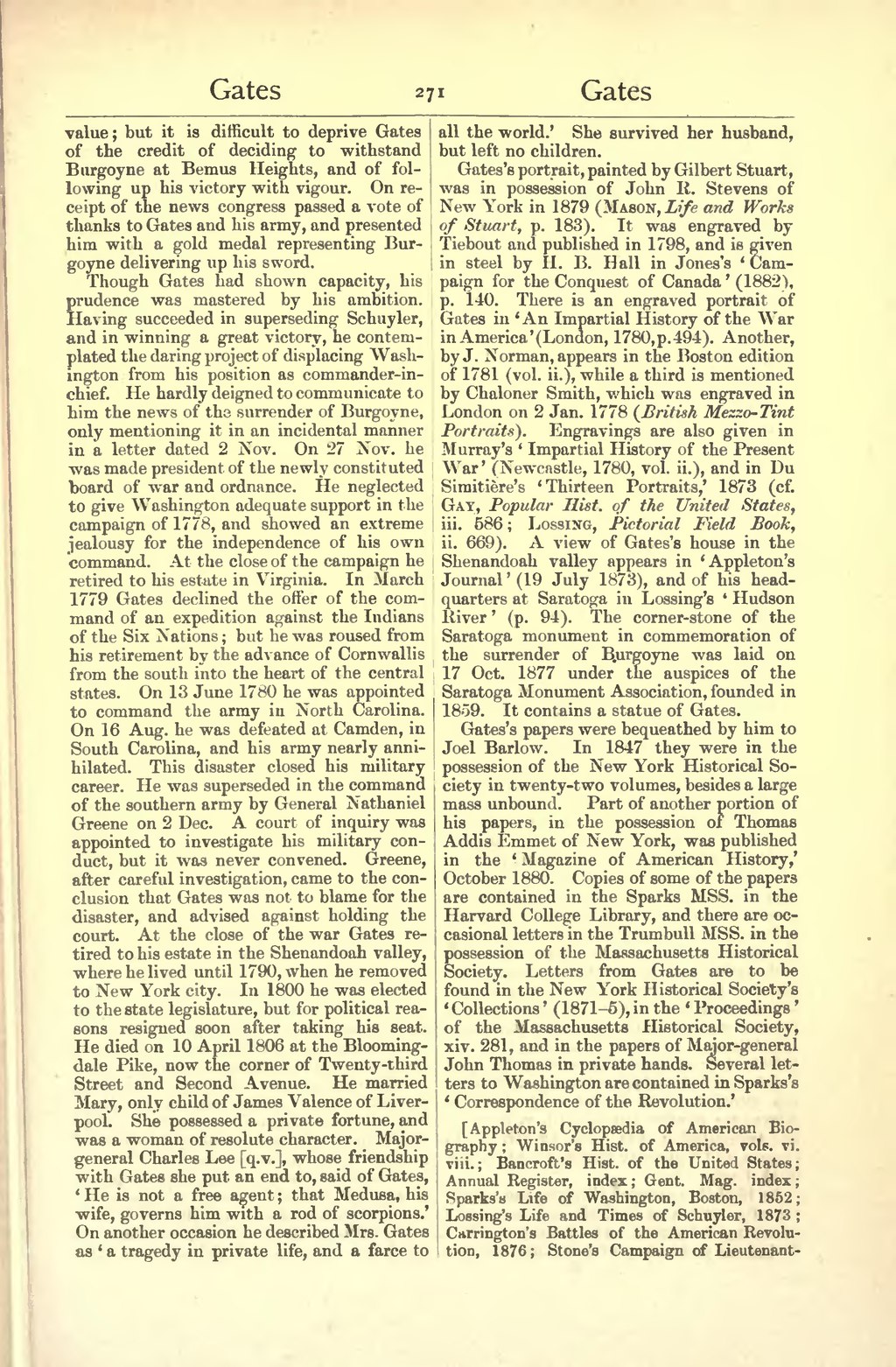value; but it is difficult to deprive Gates of the credit of deciding to withstand Burgoyne at Bemus Heights, and of following up his victory with vigour. On receipt of the news congress passed a vote of thanks to Gates and his army, and presented him with a gold medal representing Burgoyne delivering up his sword.
Though Gates had shown capacity, his prudence was mastered by his ambition. Having succeeded in superseding Schuyler, and in winning a great victory, he contemplated the daring project of displacing Washington from his position as commander-in-chief. He hardly deigned to communicate to him the news of the surrender of Burgoyne, only mentioning it in an incidental manner in a letter dated 2 Nov. On 27 Nov. he was made president of the newly constituted board of war and ordnance. He neglected to give Washington adequate support in the campaign of 1778, and showed an extreme jealousy for the independence of his own command. At the close of the campaign he retired to his estate in Virginia. In March 1779 Gates declined the offer of the command of an expedition against the Indians of the Six Nations; but he was roused from his retirement by the advance of Cornwallis from the south into the heart of the central states. On 13 June 1780 he was appointed to command the army in North Carolina. On 16 Aug. he was defeated at Camden, in South Carolina, and his army nearly annihilated. This disaster closed his military career. He was superseded in the command of the southern army by General Nathaniel Greene on 2 Dec. A court of inquiry was appointed to investigate his military conduct, but it was never convened. Greene, after careful investigation, came to the conclusion that Gates was not to blame for the disaster, and advised against holding the court. At the close of the war Gates retired to his estate in the Shenandoah valley, where he lived until 1790, when he removed to New York city. In 1800 he was elected to the state legislature, but for political reasons resigned soon after taking his seat. He died on 10 April 1806 at the Bloomingdale Pike, now the corner of Twenty-third Street and Second Avenue. He married Mary, only child of James Valence of Liverpool. She possessed a private fortune, and was a woman of resolute character. Major-general Charles Lee [q. v.], whose friendship with Gates she put an end to, said of Gates, 'He is not a free agent; that Medusa, his wife, governs him with a rod of scorpions.' On another occasion he described Mrs. Gates as 'a tragedy in private life, and a farce to all the world.' She survived her husband, but left no children.
Gates's portrait, painted by Gilbert Stuart, was in possession of John R. Stevens of New York in 1879 (Mason, Life and Works of Stuart, p. 183). It was engraved by Tiebout and published in 1798, and is given in steel by II. B. Hall in Jones's 'Campaign for the Conquest of Canada' (1882), p. 140. There is an engraved portrait of Gates in 'An Impartial History of the War in America' (London, 1780, p.494). Another, by J. Norman, appears in the Boston edition of 1781 (vol. ii.), while a third is mentioned by Chaloner Smith, which was engraved in London on 2 Jan. 1778 (British Mezzo-Tint Portraits). Engravings are also given in Murray's 'Impartial History of the Present War' ([Newcastle, 1780, vol. ii.), and in Du Simitiere's 'Thirteen Portraits,' 1873 (cf. Gay, Popular Hist. of the United States, iii. 586; Lossing, Pictorial Field Book, ii. 669). A view of Gates's house in the Shenandoah valley appears in 'Appleton's Journal '(19 July 1873), and of his headquarters at Saratoga in Lossing's 'Hudson liiver' (p. 94). The corner-stone of the Saratoga monument in commemoration of the surrender of Burgoyne was laid on 17 Oct. 1877 under the auspices of the Saratoga Monument Association, founded in 1859. It contains a statue of Gates.
Gates's papers were bequeathed by him to Joel Barlow. In 1847 they were in the possession of the New York Historical Society in twenty-two volumes, besides a large mass unbound. Part of another portion of his papers, in the possession of Thomas Addis Emmet of New York, was published in the 'Magazine of American History,' October 1880. Copies of some of the papers are contained in the Sparks MSS. in the Harvard College Library, and there are occasional letters in the Trumbull MSS. in the possession of the Massachusetts Historical Society. Letters from Gates are to be found in the New York Historical Society's 'Collections' (1871-5), in the 'Proceedings' of the Massachusetts Historical Society, xiv. 281, and in the papers of Major-general John Thomas in private hands. Several letters to Washington are contained in Sparks's 'Correspondence of the Revolution.'
